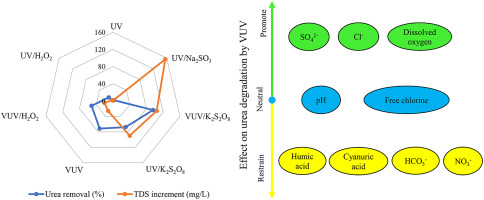Water Research ( IF 11.4 ) Pub Date : 2019-06-01 , DOI: 10.1016/j.watres.2019.05.098 Liangchen Long , Yinan Bu , Baiyang Chen , Rehan Sadiq

|
To discover an applicable technology for urea abatement from swimming pool water (SPW), this study compared the performances of seven ultraviolet (UV)-based technologies on urea removal, including UV alone, UV coupled with hydrogen peroxide (UV/H2O2), sulfite (UV/Na2SO3), potassium persulfate (UV/K2S2O8), a combination of UV and vacuum UV (UV/VUV), and UV/VUV in tandem with either H2O2 (VUV/H2O2) or potassium persulfate (VUV/K2S2O8). Among them, UV and UV/Na2SO3 showed little removal ability, and UV/H2O2 removed only 12.8% of urea within 3-h experiments, while UV/VUV degraded 71.7% of urea without introducing substantial total dissolved solids (TDS). Therefore, UV/VUV was considered as a promising technology for further exploration. In comparison, although UV/K2S2O8 exhibited higher urea removal than UV/VUV, it caused dramatic increases of TDS, which made the regulatory threshold for the TDS increment difficult to maintain. Within UV/VUV studies, some common components in SPW (e.g., cyanuric acid, humic acid, nitrate, and bicarbonate) inhibited the removal process, whereas chloride and sulfate facilitated it, while free chlorine at doses ≤ 3 mg-Cl2/L and pH levels from 6.8 to 8.0 imposed little impact on urea degradation. Overall, UV/VUV degraded 40.0% and 22.2% of urea from tap water and SPW, respectively; both were lower than the efficiency observed in ultrapure water. As for reaction byproducts, urea phototransformation via UV/VUV yielded nitrate and ammonia as the key products with the mass balance of nitrogen element being met. However, the contents of organic carbon decreased at a rate slightly lower than urea degradation, suggesting that urea was mostly mineralized and slightly converted to unknown organic compounds. The results hence demonstrate that UV/VUV is an effective alternative for urea removal from SPW.
中文翻译:

UV / VUV从游泳池水中去除尿素的作用:添加剂的作用,机理,影响因素和反应产物
为了找到一种适用于游泳池水(SPW)减排尿素的技术,本研究比较了七种基于紫外线(UV)的技术在尿素去除方面的性能,包括仅紫外线,结合紫外线与过氧化氢(UV / H 2 O 2)),亚硫酸盐(UV / Na 2 SO 3),过硫酸钾(UV / K 2 S 2 O 8),UV和真空UV(UV / VUV)的组合,以及与H 2 O 2串联的UV / VUV (VUV / H 2 O 2)或过硫酸钾(VUV / K 2 S 2 O 8)。其中,UV和UV / Na 2在3小时的实验中,SO 3的去除能力很小,UV / H 2 O 2仅去除了12.8%的尿素,而UV / VUV降解了71.7%的尿素而未引入大量的总溶解固体(TDS)。因此,UV / VUV被认为是进一步探索的有前途的技术。相比之下,虽然UV / K 2 S 2 O 8具有比UV / VUV高的尿素去除率,这导致TDS急剧增加,这使得TDS增量的调节阈值难以维持。在UV / VUV研究中,SPW中的一些常见成分(例如氰尿酸,腐殖酸,硝酸盐和碳酸氢盐)抑制了去除过程,而氯化物和硫酸盐则促进了去除过程,而游离氯的剂量≤3 mg-Cl 2/ L和pH值从6.8到8.0对尿素降解几乎没有影响。总体而言,UV / VUV分别从自来水和SPW中降解了40.0%和22.2%的尿素。两者均低于超纯水中观察到的效率。对于反应副产物,通过UV / VUV进行的尿素光转化产生了作为主要产物的硝酸盐和氨,同时满足了氮元素的质量平衡。但是,有机碳的含量下降的速度略低于尿素降解的速度,这表明尿素主要是矿化的,并轻微转化为未知的有机化合物。因此,结果表明,UV / VUV是从SPW去除尿素的有效替代方法。













































 京公网安备 11010802027423号
京公网安备 11010802027423号